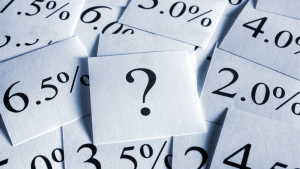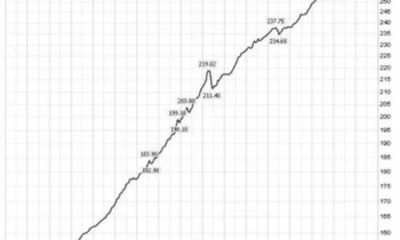Economics
The Impact of Rising Interest Rates on the Stock Market: 3 Things Investors Need to Know
The link between interest rates and the stock market follows a general pattern. That is, when interest rates are low and/or falling, economic activity…

The link between interest rates and the stock market follows a general pattern. That is, when interest rates are low and/or falling, economic activity picks up and the stock market generally goes up. On the other hand, when interest rates are rising as they are now, economic activity contracts, and the stock market generally falls.
However, this correlation between interest rates and the stock market is not as direct as many investors would like to think. In 2022, Dow Jones Market Data looked at the five rate hike cycles prior to the one that began in 2022. In four of those five cycles, the leading indexes rose over that time.
If you’re a buy-and-hold investor who won’t need your investment income for many years, staying on your current course may be the right move. However, if you have a short-term focus, you’ll have to be more proactive to protect your portfolio. But when you understand how interest rates affect companies, you’ll find there are several companies that are worthwhile investments.
What it Means: Higher Interest Rates Can Lower Earnings
 Source: travellight / Shutterstock.com
Source: travellight / Shutterstock.com
An obvious impact of higher interest rates and the stock market is the effect they can have on corporate profits. Higher rates for businesses are also felt by consumers. If consumers pull back on their spending, companies will see a decline in revenue (the top line) and earnings (the bottom line).
Higher interest rates don’t necessarily mean a company is not growing, it’s just growing slower. This is why you hear analysts refer to a company’s valuation. In economic speak, the present value of a company’s future cash flow declines. That means that investors, particularly the large institutional investors, will not overpay for a company’s stock. This puts pressure on stock prices, especially those companies that had a premium valuation when interest rates were low.
What it Means: The Cost of Money is Higher
 Source: shutterstock.com/MrIncredible
Source: shutterstock.com/MrIncredible
Younger investors have only known a monetary policy that included low interest rates for a long time with rates at or near zero percent. That lowered the cost and the burden of debt. However, as interest rates rise, the cost of that debt is going to be significantly higher. This is another phenomenon that is felt by businesses as much as by consumers.
In the first place, it means that companies that rely on debt are going to find it more difficult to get new financing. And, if they do, the cost of servicing that debt will be higher.
While this is a reality for all companies, even ones with healthy balance sheets, it will affect companies that are not profitable the most.
How to Invest: Go for Singles, not Home Runs
 Source: studiostoks / Shutterstock
Source: studiostoks / Shutterstock
Understanding what higher interest rates can mean for the stock market is one thing. The next question is what do you do about it?
For some investors, avoiding stocks may seem like a risk-free alternative. That may be true, but it’s still a bet – just one of a different sort. The reason investors say that time in the market is more important than timing the market is because it has the benefit of being true.
Having said that, this is a time when what you invest in matters. Look for high-quality companies with solid balance sheets, low debt (i.e. leverage) and ones that make high, sustainable dividend payments. These are companies that are built to perform well regardless of what direction interest rates move.
This also means looking for companies in the right sectors. The consumer staples sector is one to consider when interest rates are high. These companies sell products that consumers will need to use and keep in their budget at the expense of discretionary items. These companies also have the ability to pass along a higher percentage of their input costs, so they generally produce more stable earnings.
Energy is another sector to look at for the same reason. One option in this sector would be utility stocks. People still need water, electricity, and gas during these times. Or you can buy oil and gas stocks to lean into the fact that oil prices are on the rise.
You may notice that these aren’t traditional growth stocks. Over time, those stocks will still do well. But if you’re looking to protect your portfolio from the effect of higher interest rates this is a time to look for value over growth.
On the date of publication, Chris Markoch did not have (either directly or indirectly) any positions in the securities mentioned in this article. The opinions expressed in this article are those of the writer, subject to the InvestorPlace.com Publishing Guidelines.
Chris Markoch is a freelance financial copywriter who has been covering the market for over five years. He has been writing for InvestorPlace since 2019.
More From InvestorPlace
- Musk’s “Project Omega” May Be Set to Mint New Millionaires. Here’s How to Get In.
- ChatGPT IPO Could Shock the World, Make This Move Before the Announcement
- The Rich Use This Income Secret (NOT Dividends) Far More Than Regular Investors
The post The Impact of Rising Interest Rates on the Stock Market: 3 Things Investors Need to Know appeared first on InvestorPlace.

Argentina Is One of the Most Regulated Countries in the World
In the coming days and weeks, we can expect further, far‐reaching reform proposals that will go through the Argentine congress.
Crypto, Crude, & Crap Stocks Rally As Yield Curve Steepens, Rate-Cut Hopes Soar
Crypto, Crude, & Crap Stocks Rally As Yield Curve Steepens, Rate-Cut Hopes Soar
A weird week of macro data – strong jobless claims but…
Fed Pivot: A Blend of Confidence and Folly
Fed Pivot: Charting a New Course in Economic Strategy Dec 22, 2023 Introduction In the dynamic world of economics, the Federal Reserve, the central bank…















